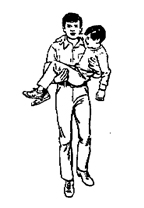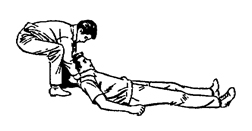During life-threatening emergencies, knowing how to evacuate an injured person is crucial because there are some instances where waiting for professionals to evacuate the patient out of a very harmful location could increase the risk of death. Therefore, in this guide, we are giving you know-how in transferring a casualty to a safe location until the first responders arrive.
Doing the following techniques must be done with absolute care and calmness because a mishandling may result in a worsening of casualty’s injuries.
Here are different techniques to move an injured individual safely. But first, you need to know t to help you assess which technique will.
If the person is conscious/responsive, know what kind of injury the person is experiencing then decide which one of these techniques is the least risky to avoid worsening the possible injury of the casualty. If the patient is unresponsive, the best thing to do is to move the patient using a technique that will keep the patient’s body aligned or as straight as possible.
Recommended techniques for a single rescuer
ON LEVELED GROUND
Ankle Pull and Elbow Pull
 Ankle Pull is best to use if there is an obvious injury on the upper part of the patient’s body. In opposite, use the Elbow Pull.
Ankle Pull is best to use if there is an obvious injury on the upper part of the patient’s body. In opposite, use the Elbow Pull.
If the patient is wearing a pant, better use the cuffs as your handle. Otherwise, firmly hold the patient’s ankle and pull with your legs. While for the Elbow Pull, firmly hold the elbow regardless of the patient’s clothing.
Pull the patient slowly as the surface may have bumps that may cause injury to other parts of the body.
Clothing Drag
 This is the alternative for the Ankle and Elbow Pull. Dragging the shoulder part of the clothing is best for casualties with multiple injuries. Using the cloth instead of gripping a body part avoids added stress to the possible injury.
This is the alternative for the Ankle and Elbow Pull. Dragging the shoulder part of the clothing is best for casualties with multiple injuries. Using the cloth instead of gripping a body part avoids added stress to the possible injury.
Make sure to grip the clothing just behind the shoulder slightly near the armpit to get a firm pull. However, the clothing might tear depending on the durability of the fabric.
ON UNEVEN GROUND / STAIRCASES
Single Person Arm Lift

If you are sure that the patient has no major injuries but cannot walk for his/her own, you may use this technique by gently lifting the person up with your hands wrapped on the back and below the knees.
One Person Pack-Strap Carry

Another alternative for the previous technique which can be used for a longer distance travel. Again, make sure the person has no major upper and lower body injuries before proceeding.
Do this while placing both the patient’s arm over your shoulders and pulling them close to your chest. Bend your knees slightly and lean forward so the weight of the patient is supported by your hip and legs.
Recommended techniques for two or more rescuers
ON UNEVEN & LEVELED GROUND
Blanket Lift (4-6 Rescuers)
 This technique is best for moving a patient with an obvious injury to keep the alignment of the body and reduce the risk of worsening their injuries. This also allows the rescuers to move the patient up and down the stairs.
This technique is best for moving a patient with an obvious injury to keep the alignment of the body and reduce the risk of worsening their injuries. This also allows the rescuers to move the patient up and down the stairs.
Do this by rolling half of the blanket and placing it beside the patient’s body. Then, 3 people kneeling on the opposite side (side B) will hold the patient’s head, neck, spine, hips and legs so the body is rolled straightly aligned towards their knees. Then, the person on the side ‘A’ will move the rolled half of the blanket near the spine of the patient. Now, gently roll back the patient flat and unroll the blanket so the patient’s body is laid on the center of the blanket.
Roll both sides of the remaining flaps of the blanket as close to the patient’s body and use them as your handle to lift the patient. Do this gently by using your leg to lift instead of your back.
Two Person Carry
 For patients without major injuries to the body, you may do a buddy system where one rescuer firmly holds the patient’s knees while the other rescuer wraps his/her arms below the armpits of the patient. Once the position is held, both rescuers will rise up slowly.
For patients without major injuries to the body, you may do a buddy system where one rescuer firmly holds the patient’s knees while the other rescuer wraps his/her arms below the armpits of the patient. Once the position is held, both rescuers will rise up slowly.
Chairs Carry
 This is an alternative technique to move the patient up and down the stairs. Use this only if the patient does not have a major body injury where a bending position will not cause discomfort.
This is an alternative technique to move the patient up and down the stairs. Use this only if the patient does not have a major body injury where a bending position will not cause discomfort.
Do this by slowly carrying the patient using the previous technique and then firmly grasping the areas of the chair as shown on the image. Use the leg when lifting the chair from the ground.
Evacuation Sling
 Another portable and lightweight equipment is the evacuation sling, such as the ProMove Sling, which is also recommended to be used when transferring a disabled individual from one point to another. This equipment is also flexible when it comes to moving an injured individual who is necessary to be lifted while in a sitting position.
Another portable and lightweight equipment is the evacuation sling, such as the ProMove Sling, which is also recommended to be used when transferring a disabled individual from one point to another. This equipment is also flexible when it comes to moving an injured individual who is necessary to be lifted while in a sitting position.
Recommended techniques for either single or multiple rescuers
ON UNEVEN AND LEVELED GROUND
Evacuation Mattress / Sheet
For rescuers who have access to evacuation equipment, such as the S-CAPEPLUS Evacuation Mattress, it will be safer and will require less effort for the rescuer/s to move the patient with multiple injuries because these evacuation mattresses are designed to move a patient on the ground and on the staircase very fast in an aligned body position with full comfort to protect the patient from discomfort and further injuries. Another portable and cheaper option would be evacuation sheets, such as the ALBACMAT, where the cushion is removed so the material is easy to fold and is lighter in weight but still gives the patient comfort and protection from the surface’s heat that is produced when the sheet is dragged.
Staircase Evacuation Chair
This equipment, such as the Spencer Pro-Skid evacuation chair, allows one or more rescuers to transport a patient – who can be in a sitting position – on a leveled ground (through the wheels) and on the staircase (through the passive slides).
There are many other equipment that are made to evacuate a casualty to safety. Having these tools as well as the proper training which is being offered by different institution and organizations is best to make sure that you are always ready and confident to save someone during life-threatening situations.
Source:
https://www.stjohn.org.nz/first-aid/first-aid-library/immediate-first-aid1/emergency-procedures/
http://disasterriskmanagement.blogspot.com/2009/03/victim-evacuationcasualties-handling.html
https://www.umgc.edu/documents/upload/evacuation-for-persons-with-disabilities.pdf


